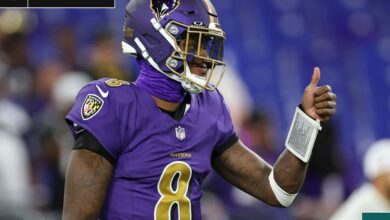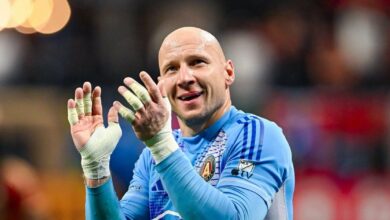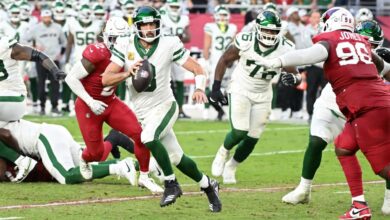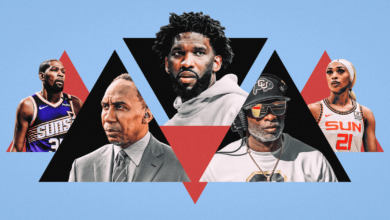NYC used to produce basketball stars. How former players hope it can become a hotbed again
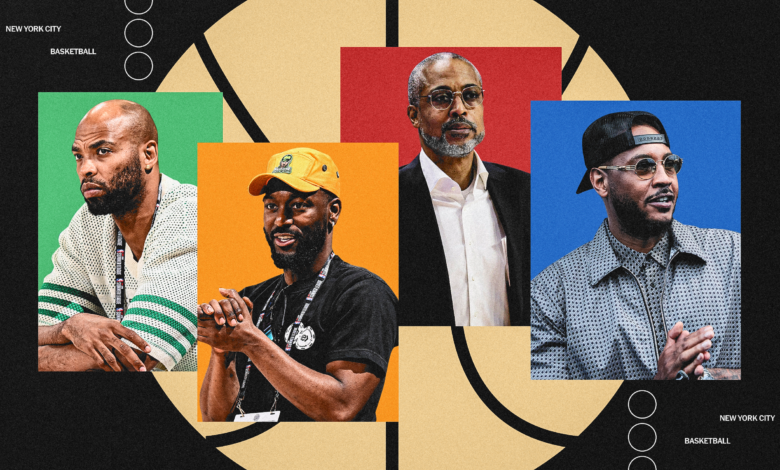
Kemba Walker is an NCAA champion and a four-time NBA All-Star. He’s also a product of the Bronx. Those things, he believes, are inextricably linked.
Walker, who retired from playing professional basketball in July and joined the Charlotte Hornets coaching staff, is one of New York City’s last great basketball stars. The city used to produce basketball players en masse, but that pipeline has slowed to a trickle over the past decade.
The city still has talent, but it’s leaving the five boroughs at a younger age. Although Walker stayed in New York before heading to the University of Connecticut, his path is no longer the norm.
“That’s changed over the years,” Walker said.
Power Memorial Academy, which produced greats like Kareem Abdul-Jabbar and Len Elmore, closed in 1984. Rice High in Harlem — where Walker and other former college stars attended — closed in 2011. Some of the area’s top players have gone to schools in New England and New Jersey.
Orlando Magic guard Cole Anthony left Archbishop Molloy in Queens for Oak Hill Academy in Virginia. Detroit Pistons forward Taj Gibson left Brooklyn for Stoneridge Prep in California. Philadelphia 76ers center Mo Bamba left the Bronx for Westtown School in Pennsylvania.
“There are still players coming (from) New York, but the problem is there are so many leaving,” said Ron Naclerio, the head coach at Benjamin N. Cardozo High School in Queens and the all-time winningest public school coach in New York history. “I hate to see this happen,” he added.
Naclerio and others, like Gibson, looked for solutions. Two New Yorkers want to make New York a hotbed for basketball again.
Griffin Taylor and Jared Effron launched The program with the intention of making New York City basketball so good that up-and-coming players don’t have to leave. Their goal is to convert an empty warehouse in the Greenpoint section of Brooklyn into a state-of-the-art youth facility with a full-sized court and an adjacent weight room, in the hopes that it will help.
“Statistically and reputationally, New York doesn’t produce as much talent as it used to,” Taylor said, “so Jared and I really wanted to find a solution to why.”

(Photo of The Program founders Griffin Taylor and Jared Effron: Courtesy of The Program)
Taylor and Effron grew up in the shadow of the New York Knicks and the St. John’s University teams of the ’90s. The sport has always been part of the city’s DNA, producing some of the best amateur and professional players in history, from Lew Alcindor to Kenny Anderson to Stephon Marbury.
Madison Square Garden is still known as the mecca of sports, but the city itself is no longer considered by some to be the epicenter.
The region’s college programs have struggled. The Knicks’ recent resurgence ended two decades of dysfunction and losing, but the 2023-24 team failed to end the franchise’s 51-year championship drought after falling to the Indiana Pacers in the Eastern Conference semifinals. The high school scene has slumped, and there’s been a talent drain from the city. According to 247 Sports, there wasn’t a single top-50 recruit from a New York City high school from 2020-23.
“There’s definitely a disconnect between the pay-for-play circuit and the AAU circuit,” said Effron, co-founder and president of The Program. “I think a big reason we haven’t been able to develop kids is because we’re not mixing that world. I don’t know if that’s a national problem, but I definitely see it here in New York.”
Gibson, who grew up through the famed New York Gauchos AAU program, felt he had no choice but to leave. Gibson said his coaches were the ones who convinced him and his mother to move to the West Coast for his sophomore year of high school, because they felt he needed a change of scenery from where he grew up. When he arrived in California, first at Stoneridge Prep and then Calvary Christian, he felt he had entered a very different basketball ecosystem.
“I’m out there and I can see it’s a different lifestyle,” Gibson said. “These guys are actually preparing to go to the pros. The way the practices were going, the way the guys were doing it. I don’t know if it was the weather … it was just a different vibe.”
Bronx native Rod Strickland, a player for the Knicks and now head coach at Long Island University, added: “Just as the NBA has become global, our country, the United States, has caught up.”
Strickland used to be a quintessential New York City product, a lightning-quick point guard with a tight grip and flair. He said the city used to create players of a certain caliber.
Naclerio believes it’s because there aren’t enough places for young players to play in the city anymore, and when they do, they’re working with coaches instead of in competitive games. One solution Naclerio suggested is more top-notch indoor courts — he has no aversion to the double-rims found in parks across New York City.
The program aims to bridge that gap by offering just that. It’s been a slow process. Taylor and Effron founded The Program in late 2021 and began hiring partners in April 2022. Last spring, they quit their full-time jobs and dedicated themselves to getting The Program off the ground. Early on, it hosted several amateur events in the metro area, attracting some of the top high school players in the state and neighboring New Jersey.
Last winter, The Program signed a lease on its first physical space, a 12,500-foot warehouse in Brooklyn’s Greenpoint neighborhood, not far from the East River, that will become a development home for some of the city’s talent. There are also plans to eventually house its teams. It’s also assembled a group of investors, including Walker, Chris Mullin and Carmelo Anthony, who believe in keeping New York City’s best young players in the city and helping them grow, just as they did.
Taylor and Effron hope to use The Program as a vehicle to provide emerging players with a space and amenities to develop their skills. Their facility will serve as a developmental academy and could eventually lead to a basketball program as well. The duo has raised just over $4 million from investors so far, Taylor said, with a goal of raising $6 million total. Roc Nation is an investor, as are JJ Redick, Miles McBride and Moe Harkless.
The NYC program has leaned on Ross Burns, a trainer for NBA players, to design its on-court agenda. It will hire coaches and instructors who have all played at least some college basketball to implement it. NBA champion and Hall of Fame broadcaster Kenny Smith will serve as an advisor, as will grassroots staple Chad Babel and longtime New England high school coach John Carroll.
The program will have annual membership plans and it also plans to offer scholarships through a children’s charity. The facility is scheduled to open in June 2025, Taylor said.
It plans to open its gym to the city’s AAU teams, and it wants to be a go-to option for NBA and WNBA teams and players who need a space to train when they’re in town during the season or offseason. Taylor and Effron also hope to have their own boys’ and girls’ teams, with Nike’s EYBL circuit as a destination.

(Rendering courtesy of The Program)
“There’s nothing better than being able to train and watch a pro train and emulate that,” Mullin said. “If that’s something that can become a reality, then that’s what it’s all about: passing on your knowledge, your daily work habits and things like that to the younger generation. That’s really how you influence and impact the people behind you.”
Mullin, who went to high school at Power Memorial in Manhattan and then Xaverian in Brooklyn, said he felt like he never had to leave. He stayed in New York, shining at St. John’s before going on to a Hall of Fame NBA career.
Gibson wants to bring back prominence and address the disconnects that have dogged the basketball scene over the past few decades. He believes the entire community needs to come together again.
There is hope and belief from him and others that it is possible to get New York City back to where it was, even though it will be difficult.
“New York City is New York City, so there’s always an opportunity,” Strickland said. “You can’t tell me there’s no talent.”
Anthony grew up in the Red Hook neighborhood of Brooklyn before moving to Baltimore at age 8. The environment Anthony sees now as he guides his son, consensus four-star guard Kiyan Anthony, through the amateur basketball ecosystem is one he wants to help create.
“I have seen first-hand how access to the best gyms, training and coaching can accelerate development,” Anthony said in a statement to The Athletics“Being able to provide accessible play space and elite coaching and training under one roof to kids across the city can only enhance the collective talent pool that comes out of New York.
“And if we can keep our most talented children at home instead of sending them away at younger ages to schools in other states and markets, that’s a win for New York on all fronts.”
Taylor and Effron also have a plan for the future. If it goes as they hope, there is room for growth. The program owns the air rights to its current location and can build on its current single-story operation. Eventually, the decision makers could expand to other major cities on the East Coast.
Walker is the latest product of the NYC high school system to make an All-Star team; his last appearance was in 2020. Walker believes he wouldn’t have reached that point if he had not only grown up in New York City but built his career there. He hopes The Program can create that path for others.
“I would want the same thing for the next generation of kids,” Walker said. “I feel like a lot of kids don’t stay in the city to pursue their basketball career. I think this could be an opportunity to let them stay and go somewhere as a safety net and a place to get better.”
(Illustration: Meech Robinson / The Athletics; photos: David Dow, Rich Schultz, Jean Catuffe / Getty Images)

